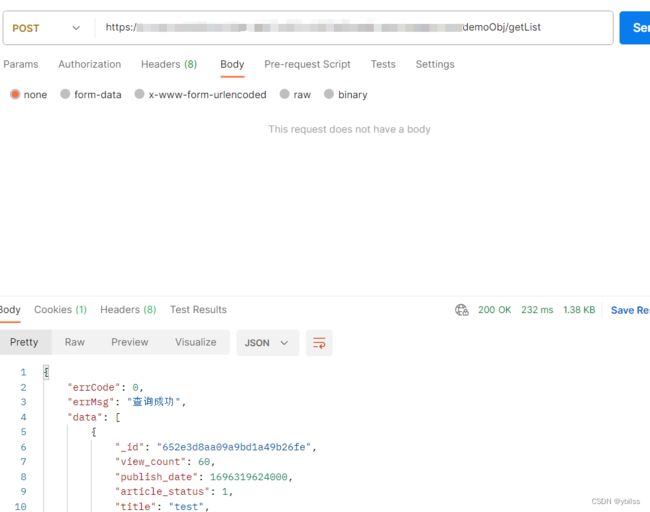uniapp(uncloud) 使用生态开发接口详情4(wangeditor 富文本, 云对象, postman 网络请求)
wangeditor 官网: https://www.wangeditor.com/v4/pages/01-%E5%BC%80%E5%A7%8B%E4%BD%BF%E7%94%A8/01-%E5%9F%BA%E6%9C%AC%E4%BD%BF%E7%94%A8.html
这里用vue2版本,用wangeditor 4
终端命令: npm i wangeditor --save
- 开始使用
在项目pages => sy_news => add.vue 页面中
<template>
//...
<uni-forms-item name="content" label="文章内容" required>
<div id="div1"></div>
</uni-forms-item>
// ...
</template>
<script>
import E from 'wangeditor'
let editor = null
// ...
onReady() {
this.onWangEdit()
},
methods:{
onWangEdit() {
editor = new E("#div1")
editor.config.zIndex = 0
// 失焦时触发的回调函数
editor.config.onblur = (newHtml) => {
this.formData.content = newHtml
}
// 将图片保存本地服务器
editor.config.customUploadImg = function(resultFiles, insertImgFn) {
resultFiles.forEach(item => {
let path = URL.createObjectURL(item)
let name = item.name
uniCloud.uploadFile({
filePath: path,
cloudPath: name
}).then(res => {
console.log("res", res);
insertImgFn(res.fileID)
})
})
}
editor.create()
},
// 提交表格
submitForm(value) {
// 修复(鼠标在富文本内,直接提交)
value.content = editor.txt.html();
//...
}
// ...
}
// ...
</script>
- 运行项目,浏览器中刷新页面,新增页面, 内容变成我们需要的富文本了,
- 修改(edit)界面同样的代码, 不过不同是
<uni-forms-item name="content" label="文章内容" required>
<div id="div1">
<div v-html="formData.content"></div>
</div>
</uni-forms-item>
// index.obj.js
const db = uniCloud.database()
module.exports = {
_before: function() { // 通用预处理器
},
async getList() {
const res = await db.collection("sy_news").get()
let result = {
errCode: 0,
errMsg: "查询成功",
data: res.data
}
return result
},
}
4.1 点击demoObj 目录, 右键, 运行本地云对象, 目录下面多一个demoObj.param.js 文件,
getList()
4.2 保存一下, 点击demoObj 目录, 右键, 运行本地云对象, 终端打印的
![]()
5. 如果带参数怎么弄?
// index.obj.js
const db = uniCloud.database()
module.exports = {
_before: function() { // 通用预处理器
this.params = this.getParams()[0]
this.startTime = Date.now()
},
async getList() {
const res = await db.collection("sy_news").get()
let result = {
errCode: 0,
errMsg: "查询成功",
data: res.data
}
return result
},
async get() {
console.log('this.params', this.params);
let {
num
} = this.params
const res = await db.collection("sy_product_nav").limit(num).get()
let result = {
errCode: 0,
errMsg: "查询成功",
data: res.data
}
return result
},
_after(error, result) {
if (error) {
throw error
}
result.timeCode = Date.now() - this.startTime
return result
}
}
// demoObj.param.js
get({
num: 2
})
在运行ok, 这都是本地运行的,
6. 接下来将 demoObj 右键 , 上传部署, 用postman请求数据
6.1 打开 uniCloud Web 控制台
6.2 云函数/云对象 => 函数/对象列表 (找到demoObj, 点击详情)
6.3 点击编辑, 输入 /demoObj

6.4 确定, 在点击(复制路径),到postman里面,改为post请求,

7. 如在postman 里面带参数, uniCloud 中 云对象 一个 getHttpInfo 的API
const db = uniCloud.database()
module.exports = {
_before: function() { // 通用预处理器
this.params = JSON.parse(this.getHttpInfo().body)
// this.httpInfo = JSON.parse(this.getHttpInfo().body)
this.startTime = Date.now()
},
async getList() {
const res = await db.collection("sy_news").get()
let result = {
errCode: 0,
errMsg: "查询成功",
data: res.data
}
return result
},
async get() {
let {
num
} = this.params
const res = await db.collection("sy_product_nav").limit(num).get()
let result = {
errCode: 0,
errMsg: "查询成功",
data: res.data
}
return result
},
_after(error, result) {
if (error) {
throw error
}
result.timeCode = Date.now() - this.startTime
return result
}
}

